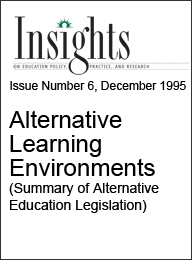Considering Broader School Reform
While it is important to consider the effectiveness of alternative education program design and implementation, policymakers should also keep in mind that alternative learning environments only represent one piece of the entire educational system. If policymakers want to ensure an effective educational system for all students, then they need to explore not only how alternative schools lead to success for some students, but also how alternative education fits into the educational system as a whole. Two issues suggest that alternative education may negatively affect the rest of the system. The first issue addresses the scope of traditional school failure, and the second addresses the effects of removing students from traditional schools.
First, alternative education is predicated on the idea that the existing educational system serves most students effectively, so only the few who are not succeeding need alternative learning environments. Thus, alternative education assumes minimal failure in traditional schools. However, some school data suggest a more extensive failure rate. Research from Little Rock, Arkansas revealed that in 1989-1991 more than two-thirds of the students enrolled in junior and senior high schools in this urban area showed indications of academic difficulty, including course failure, grade retention, dropout, suspension, expulsion, and low standardized test scores (New Futures for Little Rock Youth, 1993).
Clearly, all of these students cannot be placed in alternative environments, and placing only some is but a partial solution. Many more students who are at-risk remain in traditional classrooms where they are most likely under-served. In fact, the removal of the most disruptive students may give practitioners false confidence in the effectiveness of the existing educational program for the remaining student population. One particular group that teachers may overlook are the quiet, underachieving students.
Second, as mentioned previously, removing students from existing schools and classrooms may have a negative financial impact on these traditional programs. Unless districts receive sufficient additional funds, establishing separate alternative schools or programs draws money away from existing programs. Traditional schools then must function on a decreased budget. This reduced budget is especially detrimental if, as the data suggest, these schools must still serve many students at-risk of failure who are not placed in alternative education. In that case, fewer resources remain in traditional schools for innovative or special services to meet these students' needs.
In addition to these two issues, the idea of further segregating the student body seems antithetical to the trend toward heterogeneity within schools and classrooms. Segregating a particular student group has been shown repeatedly to have negative effects. Ironically, the emergence of separate education for students at-risk of educational failure occurs as advocates for special education students argue for increased mainstreaming or inclusion (Jordan & Jordan, 1995). If the traditional system fails many more students than those targeted for alternative settings, and if creating a separate alternative education system negatively affects the rest of the system, then policymakers may need to reconsider the efficacy of an alternative school strategy. Confronting the failures of the traditional system may be a more successful approach. The system might better serve all students by addressing the root causes of student learning problems and creating more flexible teaching and learning environments within regular classrooms and schools. Such changes may diminish negative outcomes, allowing more students to succeed within regular schools.
One might think this approach would require drastic change in public schools. Yet, successful models currently exist in exemplary schools across the nation. Furthermore, the vision of "alternatives for all" is seen in the rapidly growing charter school movement. Clearly, what alternative schools provide in the form of small classes, schools as communities, individualized attention and instruction, and many other features, would benefit all students, not just those at risk of dropping out. Some education reformers and practitioners already argue that all schools should have these features (Carnegie Task Force on Education of Young Adolescents, 1989; New Futures for Little Rock Youth, 1993). Perhaps, rather than viewing these environments as necessary alternatives for students at-risk, or fringe benefits for charter school students, a keener focus on restructuring traditional schools could make alternative environments an accepted part of the system for everyone.
The best features of alternative schools could be incorporated into regular schools. While establishing separate alternative schools for some students incurs high costs, incorporating features such as parent programs, summer school, and mentoring programs, and providing access to health and social services in the regular schools, may be more cost effective (Jordan & Jordan, 1995) and could help alleviate many of the problems faced by students in at-risk situations.
Advocates of broad-based school reform believe that such plans can improve outcomes for most students, reducing the need to separate and label students simply because their educational needs differ from the mainstream.
Next Page: Policy Considerations

